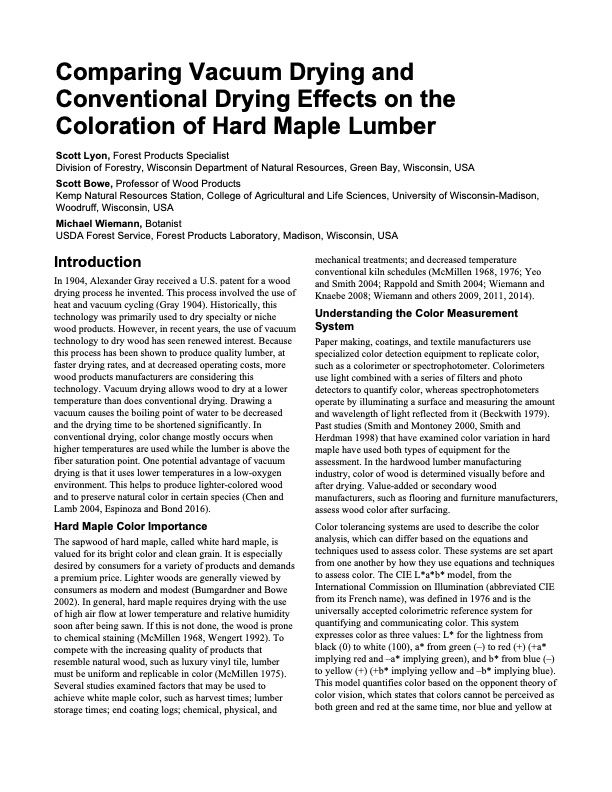
PDF Publication Title:
Text from PDF Page: 003
Comparing Vacuum Drying and Conventional Drying Effects on the Coloration of Hard Maple Lumber Scott Lyon, Forest Products Specialist Division of Forestry, Wisconsin Department of Natural Resources, Green Bay, Wisconsin, USA Scott Bowe, Professor of Wood Products Kemp Natural Resources Station, College of Agricultural and Life Sciences, University of Wisconsin-Madison, Woodruff, Wisconsin, USA Michael Wiemann, Botanist USDA Forest Service, Forest Products Laboratory, Madison, Wisconsin, USA Introduction In 1904, Alexander Gray received a U.S. patent for a wood drying process he invented. This process involved the use of heat and vacuum cycling (Gray 1904). Historically, this technology was primarily used to dry specialty or niche wood products. However, in recent years, the use of vacuum technology to dry wood has seen renewed interest. Because this process has been shown to produce quality lumber, at faster drying rates, and at decreased operating costs, more wood products manufacturers are considering this technology. Vacuum drying allows wood to dry at a lower temperature than does conventional drying. Drawing a vacuum causes the boiling point of water to be decreased and the drying time to be shortened significantly. In conventional drying, color change mostly occurs when higher temperatures are used while the lumber is above the fiber saturation point. One potential advantage of vacuum drying is that it uses lower temperatures in a low-oxygen environment. This helps to produce lighter-colored wood and to preserve natural color in certain species (Chen and Lamb 2004, Espinoza and Bond 2016). Hard Maple Color Importance The sapwood of hard maple, called white hard maple, is valued for its bright color and clean grain. It is especially desired by consumers for a variety of products and demands a premium price. Lighter woods are generally viewed by consumers as modern and modest (Bumgardner and Bowe 2002). In general, hard maple requires drying with the use of high air flow at lower temperature and relative humidity soon after being sawn. If this is not done, the wood is prone to chemical staining (McMillen 1968, Wengert 1992). To compete with the increasing quality of products that resemble natural wood, such as luxury vinyl tile, lumber must be uniform and replicable in color (McMillen 1975). Several studies examined factors that may be used to achieve white maple color, such as harvest times; lumber storage times; end coating logs; chemical, physical, and mechanical treatments; and decreased temperature conventional kiln schedules (McMillen 1968, 1976; Yeo and Smith 2004; Rappold and Smith 2004; Wiemann and Knaebe 2008; Wiemann and others 2009, 2011, 2014). Understanding the Color Measurement System Paper making, coatings, and textile manufacturers use specialized color detection equipment to replicate color, such as a colorimeter or spectrophotometer. Colorimeters use light combined with a series of filters and photo detectors to quantify color, whereas spectrophotometers operate by illuminating a surface and measuring the amount and wavelength of light reflected from it (Beckwith 1979). Past studies (Smith and Montoney 2000, Smith and Herdman 1998) that have examined color variation in hard maple have used both types of equipment for the assessment. In the hardwood lumber manufacturing industry, color of wood is determined visually before and after drying. Value-added or secondary wood manufacturers, such as flooring and furniture manufacturers, assess wood color after surfacing. Color tolerancing systems are used to describe the color analysis, which can differ based on the equations and techniques used to assess color. These systems are set apart from one another by how they use equations and techniques to assess color. The CIE L*a*b* model, from the International Commission on Illumination (abbreviated CIE from its French name), was defined in 1976 and is the universally accepted colorimetric reference system for quantifying and communicating color. This system expresses color as three values: L* for the lightness from black (0) to white (100), a* from green (–) to red (+) (+a* implying red and –a* implying green), and b* from blue (–) to yellow (+) (+b* implying yellow and –b* implying blue). This model quantifies color based on the opponent theory of color vision, which states that colors cannot be perceived as both green and red at the same time, nor blue and yellow atPDF Image | Comparing Vacuum Drying and Conventional Drying

PDF Search Title:
Comparing Vacuum Drying and Conventional DryingOriginal File Name Searched:
fpl_rp708.pdfDIY PDF Search: Google It | Yahoo | Bing
5,000 BF Shipping Container Lumber Dry Kiln For Quality Lumber The 5,000 BF container kiln consists of one 40 foot high-cube aluminum shipping container... More Info
Shipping Container Lumber Dry Kilns by Global Energy Global Energy designed and developed the container kiln back in 1991. The purpose is to give access to portable sawmill owners, furniture makers, and small business the value added profit of dry kiln lumber and quality hardwoods... More Info
Vacuum Kiln Conversion Kit for Lumber and Wood Dry Kilns Convert your existing conventional dry kiln into a fast drying vacuum kiln. Similar to vacuum bagging in the boat building and aircraft industry, we have come up with a proprietary process which allows you to build a very simple vacuum kiln at a fraction of the price, and without the intensive conventional metal chamber structure... More Info
Vacuum Pump Cart System for Bagging Clamping Wood Drying and more Vacuum Cart with 2HP Pump and Dual Pistons with multiple multiplex vacuum ports and liquid reservoir... More Info
Vacuum Bagging Basics Vacuum bagging is a method of clamping, which has traditionally been used in the composites industry, but can also be used for vacuum drying materials, including wood products... More Info
| CONTACT TEL: 608-238-6001 Email: greg@globalmicroturbine.com | RSS | AMP |